Yes, sea urchins are indeed alive. They are fascinating creatures in the ocean, known for their tiny, sharp spikes. The spikes on them make them stand out and show that they are alive as they move slowly through the ocean.
There’s a common misconception that sea urchins are lifeless, often mistaken for seashells. However, this is far from the truth. Sea urchins, like all other sea creatures, are living, breathing beings that dwell in the ocean.
Let’s explore sea urchins’ life span and learn fascinating facts about these incredible ocean animals.
How to Identify a Living or Dead Sea Urchin?
Do you recognize if a sea urchin is alive or dead? Let’s learn how to identify a dead or alive sea urchin. Here is the process you can check to identify:
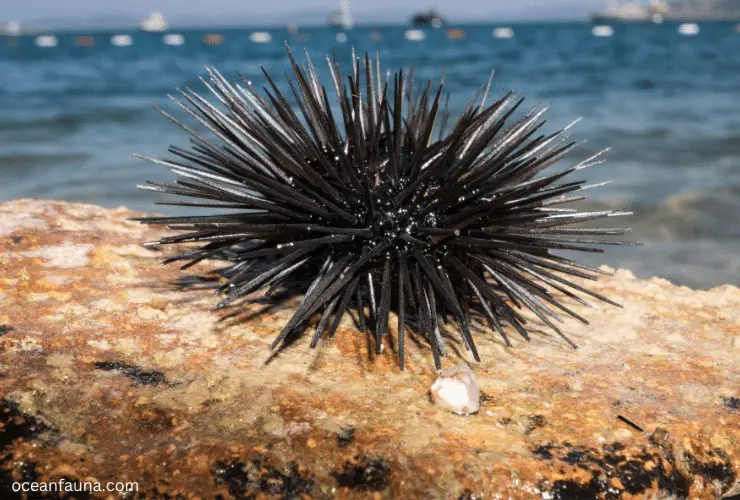
- Check the Spines: A living sea urchin ideally should have spines that are fresh and intact. The spines should not be damaged, broken or missing. These spines save the sea urchins from external attacks by predators. Furthermore, Sea urchins move similarly to starfish but without any specific direction. If a sea urchin is dead, there will be no movement detected.
- Movement: If you softly touch a sea urchin with a stick, it responds by moving its spines, tube feet, or other body parts. If you see the response, the sea urchin is most likely alive.
- Examine the Tube Feet: Sea urchins’ small tube feet help them to move and eat. If these tube feet are actively moving or responding, the sea urchin is alive.
- Color and Texture: Alive Sea urchins usually have a brighter color and smoother skin. Dead sea urchins may not look that colorful and may appear discolored, dehydrated.
- Smell: If a sea urchin is dead, you will find an unpleasant odor. So bad odor may mean the sea urchin is dead.
- Inner tissue exposed: Look at the sea urchin’s body very carefully. If you see any exposed inner tissue or shell or no spines around the body, the sea urchin is no longer alive. A living sea urchin may have a closed and intact body. (Source).
- Move in Water: If you want to be sure, you may do another test. Simply submerge the sea urchin in a container with saltwater. If the sea urchin is alive, you will that it will move the spines and tubes. Otherwise, you may consider the sea urchin dead.
Sea urchins are fragile, so handle them very carefully, even if they are dead. When you handle live sea urchins, be cautious to prevent injury because their spines are sharp and may have toxins.
In certain places, it might be against the law to gather or bother live sea urchins. So always be aware of local regulations and ethical considerations.
How Long do Sea Urchins Live?
Sea urchins are known for their impressive lifespans, although it varies by species.
In Southern California, the red sea urchin lives for nearly 50 years. In British Columbia, they can reach 100 to 200 years!
Purple sea urchins usually live for 20 years. However, some exceptional individuals have been known to live up to 70 years.
These creatures reach adulthood in 2 to 5 years and then enjoy remarkably long lives.
Fun Fact: Did you know that the red sea urchin is one of the top ten longest-living animals? It holds the eighth position in the Guinness Book of World Records!
Can Sea Urchins Survive Out of Water?
Can sea urchins live out of the water, on land?
Sea urchins’ lifespan are affected by various factors including their living environment? The survival of a sea urchin outside water also depends on its species. Some species, such as the Cidaris abyssicola, can live at very deep levels of the sea.
Similarly, many other species of sea urchins can live under shallower sea levels. Just like that, there is a certain species of sea urchins that can survive out of water for a prolonged period.
This type of urchin is known as the shingle urchin. Such sea urchins can live on the shore and are somewhat resistant to harsh sea waves. The shingle urchin is the only type of sea creature that can live out of water for many hours!
How Long Can Sea Urchins Survive Out of Water?
Sea urchins are marine animals that primarily live in the ocean. They rely on water to breathe, obtain nutrients, and regulate their internal environment. As a result, sea urchins cannot survive for extended periods out of water.
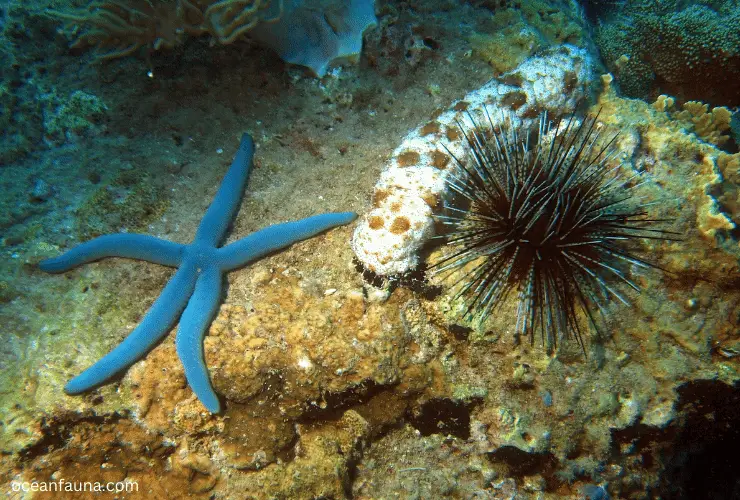
The duration a sea urchin can survive out of water varies based on factors like species, size, and environmental conditions.
Usually, they can only live for a few minutes to a few hours outside of water.
How Long Do Sea Urchins Live in Captivity?
Do you ever wonder how long sea urchins can live in captivity compared to their natural habitat? They can survive up to 200 years in the wild. But what about their life in captivity?
The answer isn’t straightforward. The lifespan of sea urchins in captivity depends on the conditions you provide. If you create the right environment, they might outlive you due to their average lifespan.
To successfully keep a sea urchin in captivity, make sure the water temperature is between 74-78 degrees Fahrenheit. Although replicating their natural habitat perfectly is not possible, with suitable conditions and proper feeding, they can live for about 3 to 6 months.
How do Sea Urchins Breathe?
Sea Urchins are exceptional because of their appearance. If sea urchins are alive, they must breathe. But how do they breathe? Do they have lungs or gills? Let’s find out.
The cool part is sea urchins don’t have traditional respiratory systems like other land animals. Instead, they have a different respiratory system to get oxygen and expel carbon dioxide.
How does the respiratory system work?
Sea urchins have a specialized system of tiny, hair-like structures called tube feet. These tube feet not only assist in movement and feeding but also play a role in respiration. They breathe through their tube feet, which have hair-like structures called cilia.
Sea urchins absorb oxygen from seawater and release carbon dioxide through these tube feet. In addition, Cilia create water flow for efficient gas exchange.
Are Sea Urchins Alive When You Eat Them?
Sea urchins are a popular ingredient in many Japanese dishes, from sushi to seafood bowls. But are sea urchins still alive when they make it to your plate?
Similar to various fish like tuna, salmon, bream, and mackerel, sea urchins are served fresh. The process of preparing a sea urchin for consumption is quite intriguing. To enjoy this unique culinary experience, crack open the shell with scissors and scoop out the vibrant orange creature.
Sea Urchin Life Cycle: From Fertilization to Reproduction
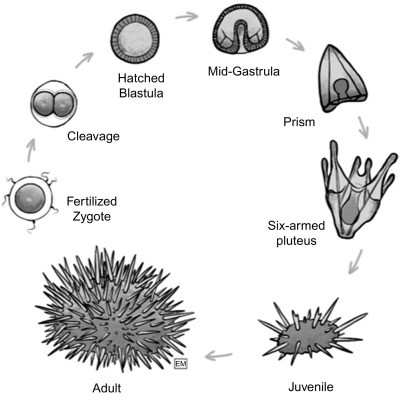
The life cycle of a sea urchin is quite interesting, and it involves several stages. Here is a brief overview of the lifecycle of sea urchin:
- Fertilized Zygote: So, it all begins with fertilization, where a lucky sperm meets up with an egg, forming a fertilized zygote. This little zygote carries all the genetic instructions for the future sea urchin.
- Cleavage: After this amazing meeting, the zygote divides into many cells quickly, which we call cleavage. But here’s the twist – the cells are dividing like crazy without actually growing much in size. It’s all about getting the party started.
- Hatched Blastula: Once the cleavage is done, the blastula hatches from its protective membrane. Now it’s free, but it’s still just a hollow ball of cells, drifting along in the water.
- Mid-Gastrula: As the embryo grows, it goes through a phase called mid-gastrula. Think of it as a significant makeover. The cells change to form three main germ layers, which will become the sea urchin’s body parts.
- Prism: Now, the prism stage is like a “teenager” in sea urchin development. It’s not quite adult yet, but it’s getting there. The adult sea urchin has a typical five-part symmetry, called pentaradial symmetry.
- Six-Armed Pluteus: Ah, the pluteus larva – it’s like the sea urchin’s “young adult” phase. It’s got these six ciliated arms that make it a great swimmer. It’s still hanging on to some larval traits, but it’s definitely growing up.
- Juvenile: Time for the “coming of age” phase. The pluteus larva undergoes metamorphosis, turning into a juvenile sea urchin. It ditches its youthful looks and starts showing off that classic sea urchin radial symmetry.
- Adult: Finally, our juvenile sea urchin matures into a full-blown adult. These guys are the grown-ups of the sea urchin world, with their spiky exoskeletons, radial symmetry, and the ability to produce eggs and sperm. This is where the circle of life continues with the next generation of sea urchins.
The exact timing and details of each stage in the sea urchin life cycle can vary among different species of sea urchins.
The table has important information about each species. It includes their development stages and time after insemination. [source]
| Species | Temp (°C) | Developmental Stage | Time After Insemination |
| S. purpuratus | 12 | 1st to 4th Cleavage | 2.5 hrs (1st) to 6.5 hrs (4th) |
| Hatching, Gastrulation | 27 hrs, 30 hrs | ||
| Early Prism to Pluteus Larva | 3 days, 4 days | ||
| Metamorphosis | 40–80 days | ||
| L. variegatus | 25 | 1st to 32 Cell Cleavage | 1 hr (1st) to 2 hrs 40 min (32 cell) |
| Hatching, Gastrulation | 7.5 hrs, 11 hrs | ||
| Early Prism to Pluteus Larva | 15 hrs, 20 hrs | ||
| L. pictus | 18 | 1st to Gastrula | 1.5 hrs (1st) to 2 days (Gastrula) |
| Pluteus | 5 days | ||
| P. miniata | 15 | 1st Cleavage, Blastula | 2.5 hrs (1st) to 9 hrs (Blastula) |
| Hatching, Gastrulation | 18 hrs, 2 days | ||
| Larval Stages to Metamorphosis | 3–4 days (Bipinnaria), 2 months (Metamorphosis) | ||
| Ophiopholis aculeata | 8 | 1st Cleavage, Gastrula | 3 hrs (1st), 1.5–2 days (Gastrula) |
| Larval Stages to Complete Metamorphosis | 10.5 days (6-Arm), 17 days (8-Arm), 83–216 days (Complete) |
What Causes Sea Urchins to Die?
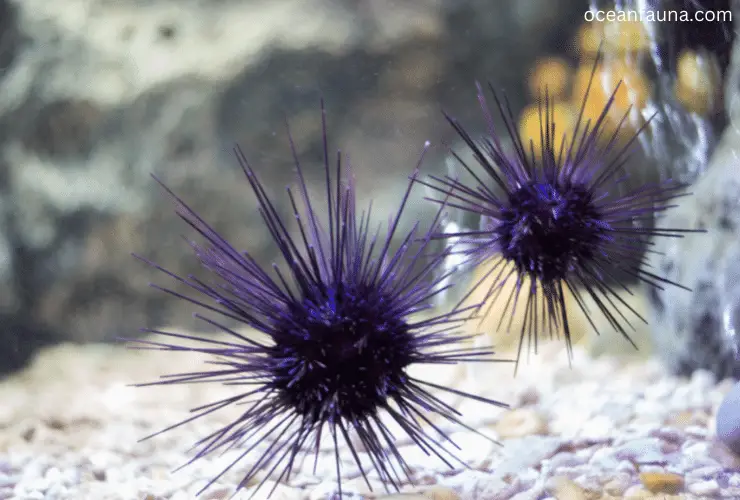
We’ve learned that sea urchins are among the longest-living animals. You might wonder if they all die of old age. Let’s explore the reasons behind sea urchin mortality.
- Predators such as fish, otters, and birds threaten sea urchins by causing injury or death.
- Changes in the environment, such as temperature, water quality, and pollution, can cause stress and death.
- If people collect too many sea urchins, it can make their numbers go down and even disappear from some places. Sea urchins are valued in certain cuisines for their “roe” or “uni.”
- High ocean temperatures and stony coral tissue loss cause coral bleaching, which often kills sea urchins.
- The destruction of habitats from fishing and coastal development harms kelp forests and rocky reefs. This reduces food and shelter and leads to their decline.
- When there’s more carbon dioxide in the air, the ocean becomes more acidic. This makes it hard for sea creatures, like sea urchins, to make and keep their hard shells.
- Harmful algal blooms produce toxins that can be lethal when ingested by sea urchins.
- Sea urchins, like all living things, have a natural lifespan. As they get older, their bodies become weaker and more susceptible to stress, which eventually leads to their death.
- In some places, sea urchins may starve and die because they have to compete for food.
- Accidents or storms can also lead to the demise of sea urchins.
What Happens After Sea Urchins Die
After sea urchins die, their bodies decompose and release nutrients into the environment. Scavengers and detritivores eat their remains. Their exoskeletons, made of calcium carbonate, can last a long time.
When sea urchins die, it can affect how ecosystems work, especially in places where they keep algae in check. The consequences vary depending on the ecosystem and other factors.
FAQs
Can Sea Urchins Kill Humans?
Sea urchins have spiny defenses that can be painful if you step on them. However, they’re not life-threatening.That’s why it’s crucial to steer clear of sea urchins if you spot them.
Are Sea Urchins Immortal?
No, sea urchins aren’t immortal. However, they have remarkable longevity – most can live up to a century! They can regrow and regenerate damaged parts and reproduce throughout their lives.
What Happens if you Touch a Sea Urchin?
Avoid touching sea urchins whenever possible. Pressing too hard can cause a painful sting, leading to severe health issues and even death. Be cautious around them.
Conclusion
That’s all for today’s discussion about sea urchins and their impressive lifespans. If you find a stranded sea urchin, this article provides signs to identify its condition.
I trust this article has addressed your sea urchin queries. If you come across a sea urchin dish, don’t miss the chance to try it!

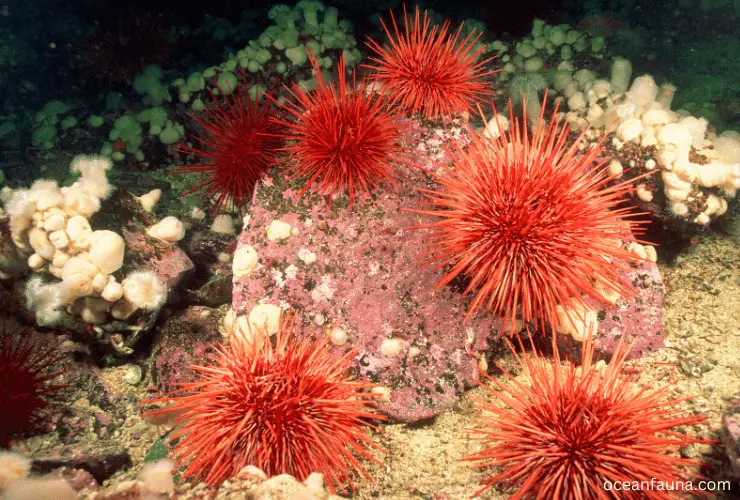
4 thoughts on “Are Sea Urchins Alive? Exploring Their Lifespan & Survival”